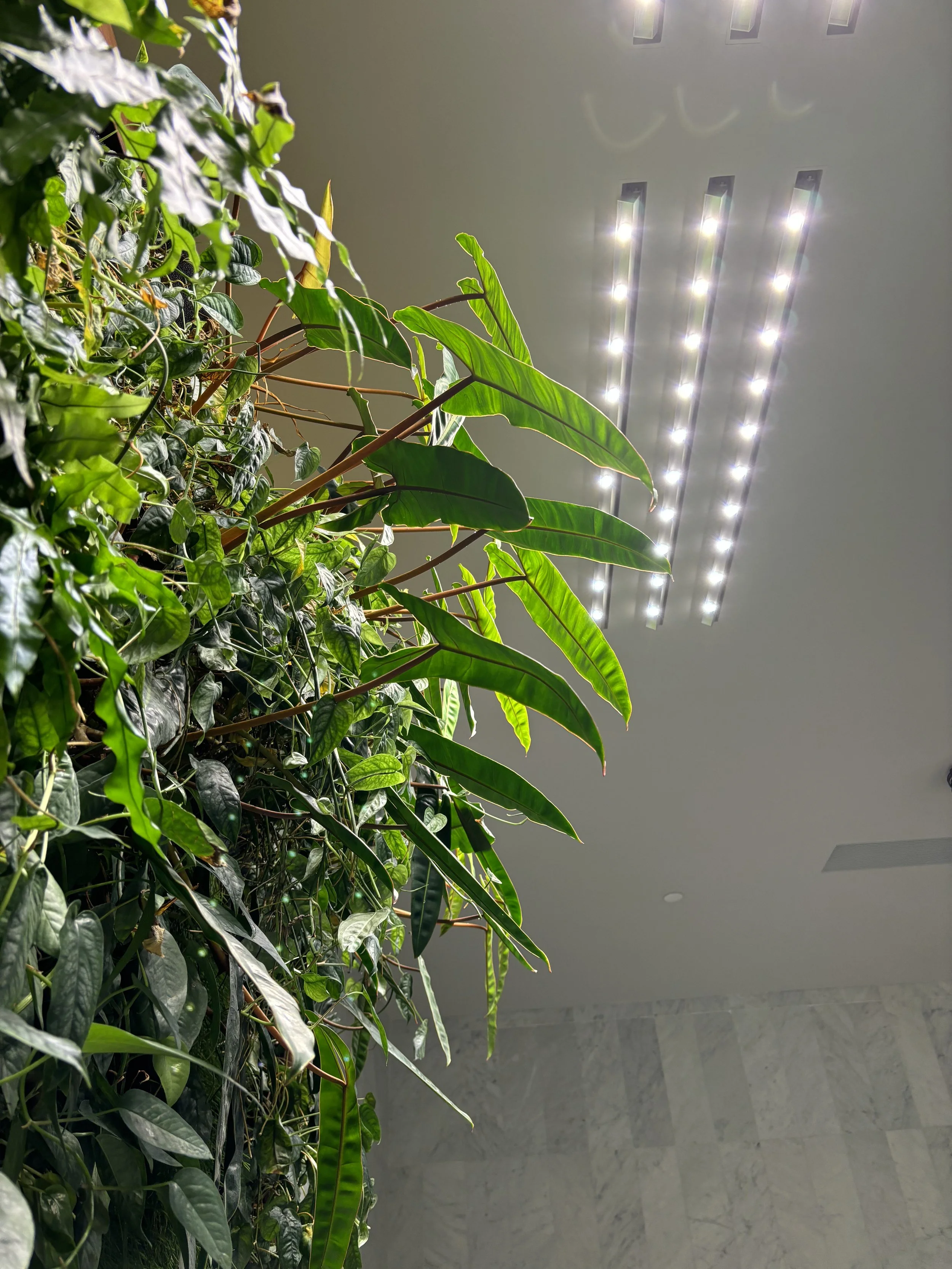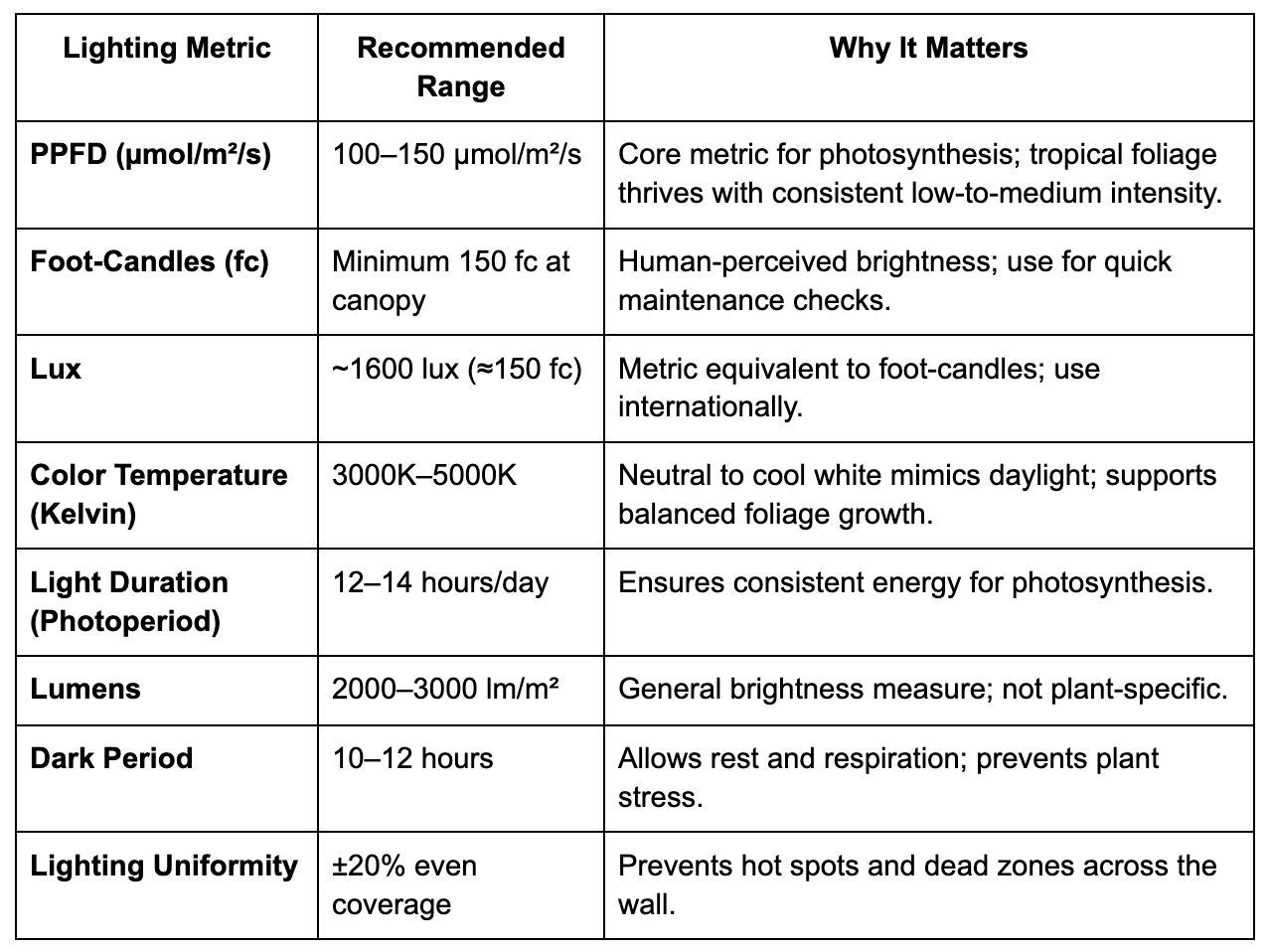The Science of Lighting for Living Walls: Getting Plant Light Levels Right
I want to talk about something often undervalued in the world of interior living walls: lighting. Too often, designers or contractors underestimate how much light tropical foliage truly needs. Whether due to budget cuts, aesthetic preferences, or simple oversight, inadequate lighting can turn a lush vertical garden into a maintenance nightmare.
Early Lessons: The Real Cost of Poor Lighting
In the early years of my career, I learned this lesson the hard way. I agreed to lighting designs that were “close enough” or visually minimal to satisfy architects, simply to get the project approved or avoid the impression that living walls are high maintenance. But the outcome was always the same: plants underperformed, aesthetics suffered, and our maintenance costs ballooned. And since most of our clients were on annual contracts, I couldn’t return mid-year and ask for more budget due to "bad light" and inevitable resources to rectify the effects.
The symptoms were clear: leggy growth, yellowing leaves, stunted foliage, and worst of all, increased pest infestations. It became painfully obvious: plants without adequate lighting are like humans without proper nutrition or rest. Their immune systems weaken, they struggle to grow, and they become magnets for disease and stress.
Light isn’t optional for plants. It’s their food. You wouldn’t deprive a team of nutrients and expect top performance; the same goes for your living wall system.
Light balancing at Columbia University- Manhattan, NY
Natural Light Isn’t Enough Indoors
Designers often assume that windows or skylights can sustain interior living walls, which I don’t blame them; especially if they are considering their houseplants lined up on the windowsill at home, or haven’t worked with a living wall before. But unless you’ve measured the light levels throughout the day, it’s extremely risky.
Light from a south-facing window at 10 a.m. might look bright but by 3 p.m., the intensity can drop dramatically. Seasonal changes also shift the total daily light integral (DLI) plants receive. In most interior environments, natural light simply isn’t consistent or strong enough for tropical foliage to thrive.
Recommended Light Levels for Living Walls
This is one of the more debated topics in living wall design. Some professionals claim 75 foot-candles is enough; others insist on 120 fc. Personally, I aim for 150 foot-candles minimum, especially on larger installations.
More surface area means more potential for uneven coverage, so starting strong ensures that even lower rows meet the plant’s minimum requirements.
However, remember: foot-candles, lumens, and lux measure brightness for human eyes, not for plants. Plants use light energy differently, which is why we also rely on PPF and PPFD (Photosynthetic Photon Flux Density) to measure usable light for photosynthesis.
Key Lighting Metrics for Living Wall Success
Expert Insight: Why Lens Design and Spectrum Matter
I often refer clients to Jonah Adamcik, Commercial Sales & Product Operations at Soltech Solutions, one of our trusted lighting partners for living walls. Jonah has helped bridge the gap between visual brightness and horticultural light performance, a distinction that defines plant success.
“Plants operate in PPF and PPFD, but a lot of contractors operate in lumens and foot-candles,” says Adamcik. “That disconnect can make it challenging to ensure the right lights are specified from the start.”
He points out that two of the largest misconceptions in architectural lighting design are improper lensing and overreliance on human-centric metrics:
“Without proper lenses, a fixture’s PPF doesn’t always translate to PPFD at the plant surface,” Adamcik explains. “Many competitors claim high PPF, but without lenses or reflectors, very little light actually reaches the foliage. That’s why we use 60°, 36°, and 19° lens options depending on throw distance.”
“Foot-candles and lumens are secondary,” he continues. “They don’t measure spectral quality. Two lights can both read 150 fc, but if one isn’t full-spectrum, the plants receive far less usable energy.”
This perspective reinforces a key takeaway: living wall lighting is about precision, not brightness.
How Long Should Living Wall Lights Stay On?
The optimal photoperiod or “day length” for most tropical living wall species is 12 to 14 hours of light per day. Anything less and growth slows; too much continuous light can cause metabolic stress.
Darkness Period: Put Your Plants To Bed!
Plants need downtime, too. During darkness, they complete essential metabolic and respiratory cycles. Research from Plant Signaling & Behavior (2019) shows that circadian regulation affects photosynthetic efficiency and stress response, even in shade-tolerant plants.
In our experience, walls with consistent light/dark cycles exhibit fewer pest problems and more balanced growth than those under constant light.
Consequences of Inadequate Lighting
Pest Infestations: Mealybugs, aphids, spider mites, and scale insects thrive in low-light, stressed conditions.
More maintenance: Weak plants require frequent pruning and replacements.
Hidden long-term costs: Savings on fixtures often result in ongoing maintenance expenses and client dissatisfaction.
Even with topical sprays and biological controls, pest eradication becomes costly and outbreaks recur if the lighting remains poor.
The Bottom Line: Invest Upfront, Save Downstream
Lighting isn’t optional. It’s the foundation of plant health!
By investing in proper horticultural-grade fixtures and automated lighting controls, you protect both your project and your reputation. When living walls are properly lit, they not only look better but, last longer and prove that living plant walls are a viable, sustainable solution for modern interiors.
Need help integrating a living plant wall into your next project?
Urbanstrong collaborates early on with architect and construction teams to ensure the green wall is built in a cost-effective and seamless way, offering a better experience for trade partners and a thoughtful aesthetic. Click here to get the conversation started!
About the Author
Lily has over a decade of experience across the United States as a biophilic designer, project manager, and living wall design-build specialist. She has a unique perspective on how we can unify our approach to design, planning, and development in a way that recognizes the social, environmental, and economic value of living architecture; to make our urban cities more green.
Today, she closely works with architects/designers and contractors to best offer a technology suited for their budget, design parameters, and scale. Lily also serves as Chair of the Green Roof's for Healthy Cities’ Living Wall Committee and Green Plants for Green Buildings Committee member.
References & Further Reading
Björn, L. O. (2015). Photobiology: The Science of Light and Life. Download
Trouwborst et al. (2010). The Impact of Light Spectrum on Plant Morphology and Physiology. Acta Horticulturae. Read here
Circadian Rhythms in Plants. (2019). Plant Signaling & Behavior. Read here
Soltech Solutions. (n.d.). Highland Track Light System. Retrieved October 14, 2025, from soltech.com
Adamcik, Jonah.Commercial Sales & Product Operations, Soltech Solutions. Personal communication, October 2025.







